
NATO: Operational Combat in Europe in the 1970s is a board wargame published by Simulations Publications Inc. (SPI) in 1973 that simulates an invasion of Western Europe by the Warsaw Pact.

NATO: Operational Combat in Europe in the 1970s is a board wargame published by Simulations Publications Inc. (SPI) in 1973 that simulates an invasion of Western Europe by the Warsaw Pact.
NATO is a tactical wargame at the divisional level for two players that simulates a surprise attack by Warsaw Pact forces against NATO forces defending Western Europe in the 1970s. [1]
The game comes with: [1]
The game comes with four scenarios: [1]
Both players earn Victory Points by destroying enemy units, and by capturing or recapturing cities. Each scenario lasts 20 Turns once hostilities commence. The player with the most Victory Points at the end of the scenario wins the game. [1]
NATO was designed by Jim Dunnigan and published by SPI in 1973. [1]
In 2003, Decision Games acquired the license to the game, revised and streamlined the rules, and republished it in Strategy & Tactics #220 as Group of Soviet Forces Germany. [2]
In 2018, Compass Games acquired the license for the game and reimplemented it as Brezhnev's War: NATO vs. the Warsaw Pact in Germany, 1980, hypothesizing an invasion of Western Europe after the fall of Saigon and before the Soviet invasion of Afghanistan. [3]
In his 1977 book The Comprehensive Guide to Board Wargaming , Nicholas Palmer noted the relatively high rating of this game in a 1977 poll conducted by SPI (44th out of 209 games), commenting "The poll takes a jaundiced view of many operational-level games, but it rates this one well, and with good reason." Palmer liked the back-and-forth nature of the game, as the NATO forces inevitably thrown back by the Soviets start to stiffen in good defensive positions. He concluded, "Some queries on realism, but thrilling from start to finish." [4]
In the July/August 1978 issue of Phoenix (#14), Ralph Vickers gave an in-depth review of the original SPI game, and found that the various design factors of the game "not only allow the players to draw on the full arsenal of subterfuge and surprise but also the many ways NATO can be played strategically makes a game of long-lasting interest." Vickers did find some problems with the rules, especially the special rules for Denmark, commenting "It is difficult to imagine why these cumbersome, hairy, creaking rules were included in this otherwise lean, clean game." Despite this, Vickers concluded with a strong recommendation, saying, "All in all, NATO properly played is a fascinating game — in almost every regard it's a classic." [1]
In Issue 31 of The Wargamer , John D. Burtt compared the 10-year-old game NATO to just-published The Red Storm published by Yaquinto Games. He found NATO to be a much more complex game, and used unit movement as an example: In Red Storm, all units use one standard type of movement, but in NATO there are eight different options for movement. Burtt pointed out several other areas where the rules of NATO involve much more complexity, including supply lines, tactical nuclear weaspons, and combat. He did feel the rules for NATO had been created in a rush, as evidenced by the three pages of errata. Despite this, Burtt concluded that he preferred the much more complex NATO to the simpler Red Storm, saying that NATO "provided a more satisfying game experience." [5]
At the 2005 Origins Awards, Decision Games' 2003 edition, Group of Soviet Forces Germany, was a finalist for the "Charles S. Roberts Best Modern Era Boardgame of 2004", and the "Charles S. Roberts Best Magazine-Published Boardgame of 2004". [2]

1776, subtitled "The Game of the American Revolutionary War", is a board wargame published by Avalon Hill in 1974 that simulates the American Revolutionary War. Its release was timed to coincide with the bicentenary of the Revolution, and for several years was a bestseller for Avalon Hill.
Sniper!, subtitled "House-to-House Fighting in World War II", is a two-player board wargame about man-to-man combat in urban environments during WWII, originally released in 1973 by Simulations Publications Inc. (SPI). After TSR purchased SPI in 1982, TSR released an expanded edition of Sniper! in 1986, and followed up that up with releases of various "companion games" and a videogame.
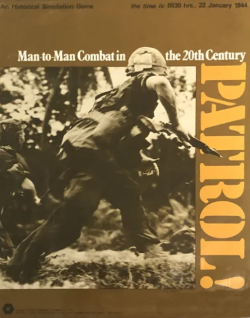
Patrol, subtitled "Man to Man Combat in the 20th Century", is a skirmish-level board wargame published by Simulations Publications Inc. (SPI) in 1974 as a sequel to Sniper!, which had been released the previous year. Whereas Sniper! was set in urban environments during the Second World War, Patrol is set in a non-urban environment, in various conflicts ranging from 1914 to 1970.
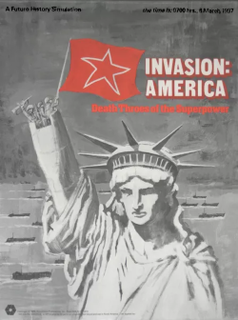
Invasion: America, subtitled "Death Throes of the Superpower", is a near-future board wargame published by SPI in 1976 that simulates a hypothetical coordinated attack on North America by various factions.

The Next War: Modern Conflict in Europe is a board wargame published by Simulations Publications, Inc. (SPI) in 1978 that simulates a hypothetical Warsaw Pact invasion of Western Europe.
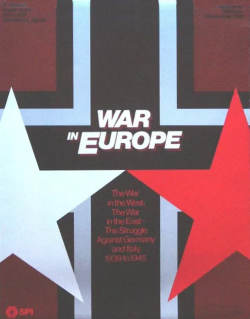
War in Europe is a grand strategic "monster" board wargame published by Simulations Publications Inc. (SPI) in 1976 that attempts to simulate the entirety of World War II's European theater of operations from 1939 to 1945. One of the largest wargames ever produced, War in Europe features 4000 counters, four rulebooks, and nine maps that when placed together cover an area of 38.5 ft2. The game is nominally a three-player game, but each side can be represented by teams of players. SPI estimated the full game would take at least 180 hours.

StarForce: Alpha Centauri, subtitled "Interstellar Conflict in the 25th Century", is a science fiction board game published by Simulations Publications Inc. (SPI) in 1974. It was the first mass-market science fiction board game, and was a best-seller for SPI.

Highway to the Reich is a grand tactical monster board wargame published by Simulations Publications, Inc. (SPI) in 1976 that simulates the World War II Allied operation known as Operation Market Garden.

Armageddon: Tactical Combat, 3000-500 BC is a board wargame first published by Simulations Publications Inc. (SPI) in 1972 in Strategy & Tactics, then released as a stand-alone game, then reimplemented as Chariot: Tactical Warfare in the "Biblical" Age, 3000-500 BC.

Berlin '85, subtitled "The Enemy at the Gates", is a battalion-level board wargame published by Simulations Publications, Inc. (SPI) in 1980 that hypothesizes an attack on West Berlin by the Warsaw Pact.

Fifth Corps, subtitled "The Soviet Breakthrough at Fulda", is a board wargame published by Simulations Publications, Inc. (SPI) in 1980 that simulates a hypothetical invasion of West Germany by Warsaw Pact forces. The game is the first in the Central Front series of games.
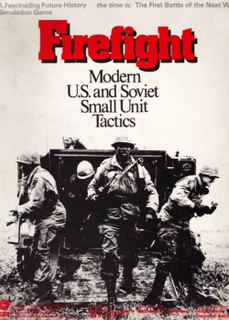
Firefight: Modern U.S. and Soviet Small Unit Tactics is a tactical wargame originally published by Simulations Publications, Inc. (SPI) in 1976 that hypothesizes combat between small units of American and Soviet forces in West Germany in the 1970s.
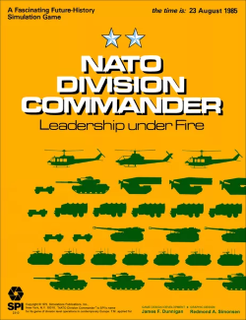
NATO Division Commander, subtitled "Leadership Under Fire", is a board wargame published by Simulations Publications Inc. (SPI) in 1980 that simulates hypothetical World War III ground combat scenarios in Europe between NATO and Warsaw Pact forces using armaments of the 1970s.
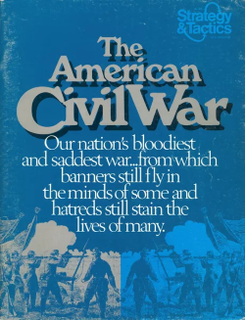
The American Civil War: 1861–1865 is a board wargame published by Simulations Publications Inc. (SPI) in 1974 that is a strategic simulation of the American Civil War.
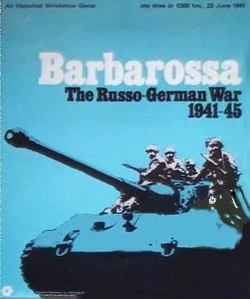
Barbarossa: The Russo-German War 1941-45 is a board wargame published by Simulations Publications Inc. (SPI) in 1969 that simulates the conflict between Germany and the Soviet Union on the Eastern Front of World War II. This was only SPI's second game produced during a preliminary round of "Test Series" games, and proved to be the most popular. Despite the title, taken from the German operational name for their initial invasion of the Soviet Union, the game covers the entire Eastern Front campaign from the German invasion in 1941 to the Fall of Berlin in 1945.

The Fast Carriers, subtitled "Air-Sea Operations, 1941–77" is a board wargame published by Simulations Publications Inc. (SPI) in 1975 that simulates naval combat involving aircraft carriers from 1941 to the mid-1970s.
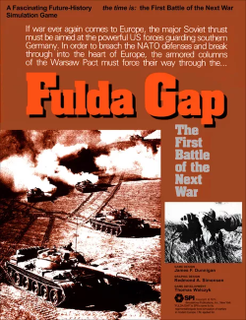
Fulda Gap, subtitled "The First Battle of the Next War", is a board wargame published by Simulations Publications Inc. (SPI) in 1977 that simulates a hypothetical attack by Warsaw Pact forces against NATO defenders in West Germany using technology and tactics of the mid-1970s
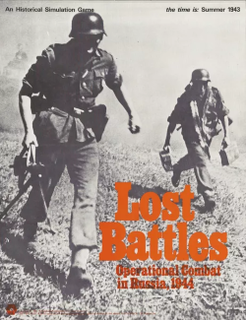
Lost Battles: Operational Combat in Russia is a board wargame published by Simulations Publications Inc. (SPI) in 1971 that simulates hypothetical combat situations set in the Soviet Union during World War II.

MechWar '77, subtitled "Tactical Armored Combat in the 1970s", is a board wargame published by Simulations Publications Inc. (SPI) in 1975 that simulates hypothetical tank combat in the mid-1970s between various adversaries, using the same rules system as the previously published Panzer '44.

Napoleon at Waterloo is a board wargame published by Simulations Publications Inc. (SPI) in 1971 that simulates the Battle of Waterloo. The game, which features simple rules, was designed as an introduction to board wargaming, and was given as a free gift with each subscription to SPI's Strategy & Tactics magazine.